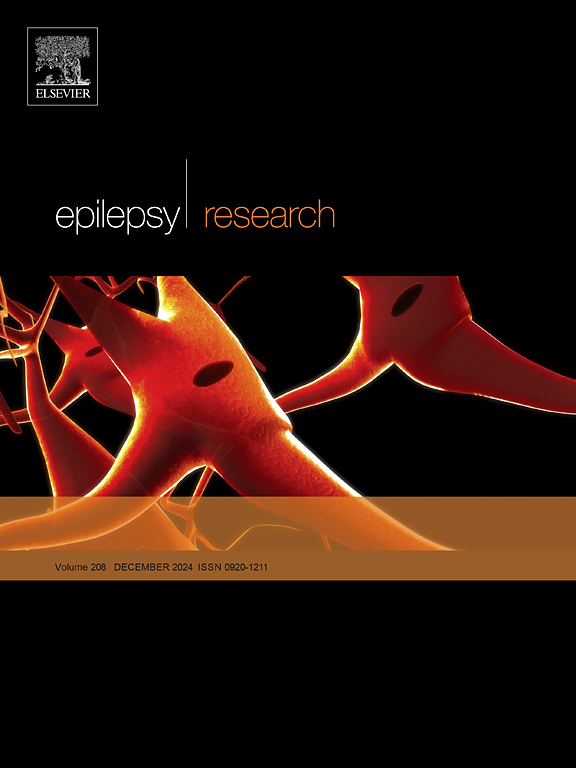应用食品药品监督管理局不良事件报告系统对左乙拉西坦抗癫痫药物致敌意/攻击的主成分分析及因子分析
IF 2
4区 医学
Q3 CLINICAL NEUROLOGY
引用次数: 0
摘要
全世界约有5000万人患有癫痫。抗癫痫药物(asm)是控制癫痫发作的必要药物。然而,不良的精神影响,特别是敌意和攻击,影响治疗依从性和生活质量。这些不良反应的风险因素和机制尚不清楚。目的利用美国食品药品监督管理局不良事件报告系统(FAERS)全球药物警戒数据库对asm诱导的敌意/攻击进行分类,重点研究左乙拉西坦诱导的敌意/攻击的危险因素和发病模式。方法分析FAERS数据库(2004年第一季度- 2022年第一季度),计算asm诱发的敌意/攻击的报告优势比,并采用主成分分析法对其进行分类。检查左乙拉西坦引起的不良反应和相关的独立危险因素。结果主成分分析确定了8种由asm引起的不良反应,包括“攻击性”、“愤怒”、“杀人意念”和“敌意”。在年龄≥ 12岁服用左乙拉西坦的患者中,男性、年龄较小和特定的伴随药物是左乙拉西坦引起不良反应的独立危险因素。左乙拉西坦引起的不良反应表现为早期失效模式,≥ 12岁患者的中位发病时间为4.5天,≥ 12岁患者的中位发病时间为1.5天。结论本研究对asm诱导的敌意/攻击行为进行了分类,并对左乙拉西坦诱导不良反应的危险因素进行了评估。特别是,我们确定了早发模式和高危患者概况。这些发现与临床观察结果一致,并为这些不良反应的机制提供了见解,这将有助于主动风险管理和个性化治疗策略。本文章由计算机程序翻译,如有差异,请以英文原文为准。
Principal component analysis of antiseizure medication-induced hostility/aggression and factor analysis of levetiracetam using the food and drug administration adverse event reporting system
Background
Epilepsy affects approximately 50 million people worldwide. Antiseizure medications (ASMs) are essential for seizure control. However, adverse psychiatric effects, particularly hostility and aggression, affect treatment adherence and the quality of life. The risk factors and mechanisms underlying these adverse effects remain unclear.
Objective
This study aimed to classify ASM-induced hostility/aggression using the Food and Drug Administration Adverse Event Reporting System (FAERS), a global pharmacovigilance database, focusing on the risk factors and onset patterns of levetiracetam-induced hostility/aggression.
Methods
The FAERS database (2004 Q1–2022 Q1) was analyzed to calculate the reporting odds ratios for ASM-induced hostility/aggression, which were classified using a principal component analysis. Levetiracetam-induced adverse effects and the associated independent risk factors were examined. Weibull distribution analysis was used to assess the time-to-onset patterns
Results
Principal component analysis identified eight ASM-induced adverse effects, including "aggression," "anger,” “homicidal ideation," and "hostility." In those taking levetiracetam aged ≥ 12 years, male sex, younger age, and specific concomitant medications were independent risk factors for levetiracetam-induced adverse effects. Levetiracetam-induced adverse effects exhibited an early failure pattern, with a median onset of 4.5 days in patients aged ≥ 12 years and 1.5 days in those < 12 years.
Conclusion
In this study, we classified ASM-induced hostility/aggression and estimated the risk factors for levetiracetam-induced adverse effects. In particular, we identified early-onset patterns and high-risk patient profiles. These findings are consistent with clinical observations and provide insight into the mechanisms underlying these adverse effects, which will contribute to proactive risk management and personalized treatment strategies.
求助全文
通过发布文献求助,成功后即可免费获取论文全文。
去求助
来源期刊

Epilepsy Research
医学-临床神经学
CiteScore
0.10
自引率
4.50%
发文量
143
审稿时长
62 days
期刊介绍:
Epilepsy Research provides for publication of high quality articles in both basic and clinical epilepsy research, with a special emphasis on translational research that ultimately relates to epilepsy as a human condition. The journal is intended to provide a forum for reporting the best and most rigorous epilepsy research from all disciplines ranging from biophysics and molecular biology to epidemiological and psychosocial research. As such the journal will publish original papers relevant to epilepsy from any scientific discipline and also studies of a multidisciplinary nature. Clinical and experimental research papers adopting fresh conceptual approaches to the study of epilepsy and its treatment are encouraged. The overriding criteria for publication are novelty, significant clinical or experimental relevance, and interest to a multidisciplinary audience in the broad arena of epilepsy. Review articles focused on any topic of epilepsy research will also be considered, but only if they present an exceptionally clear synthesis of current knowledge and future directions of a research area, based on a critical assessment of the available data or on hypotheses that are likely to stimulate more critical thinking and further advances in an area of epilepsy research.
 求助内容:
求助内容: 应助结果提醒方式:
应助结果提醒方式:


